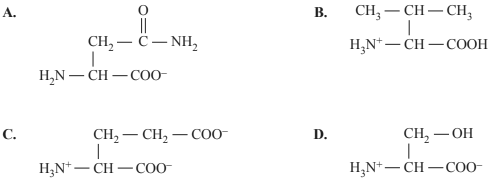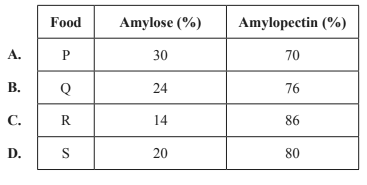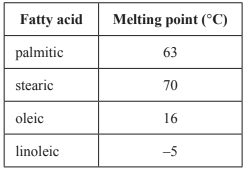1) A hydrolytic reaction occurs when
A. a dipeptide is formed.
B. a triglyceride is formed.
C. water is a reaction product.
D. glucose is formed from maltose.
Solution

2) An enzyme
A. can distinguish between optical isomers.
B. catalyses forward and reverse reactions.
C. always needs a coenzyme to function.
D. is not able to change shape.
Solution

3) The nutrition information panel on a packet of muesli includes the following information.

Using the information above, the percentage energy content due to protein in an average serving size of this muesli is
A. 31.2%
B. 29.3%
C. 14.0%
D. 13.2%
Solution

4) Which one of the following structures represents a zwitterion of a 2-amino acid?

Solution

5) When stored under identical conditions, which one of the following fatty acids is likely to undergo oxidative rancidity in the shortest time?
A. linolenic acid
B. linoleic acid
C. stearic acid
D. oleic acid
Solution

6) Which one of the following is a correct statement about the denaturation of a protein?
A. Denaturation is characterised by the release of peptides.
B. Alcohol denatures proteins by disrupting the hydrogen bonding.
C. Denaturation involves disruption of all bonds in the tertiary structure.
D. The primary and secondary structures are disrupted when denaturation occurs.
Solution

7) A patient’s blood tests indicate clinically low levels of vitamins C and D. Which one of the following recommendations would most effectively and safely increase the patient’s levels of both vitamins C and D?
A. Take a supplement of oil containing vitamin D regularly and eat citrus fruit daily.
B. Eat more dairy products and spend one hour per day in the sun wearing sun protection.
C. Dissolve a vitamin C tablet and a vitamin D tablet in a glass of water each morning and drink it.
D. Eat more green leafy vegetables and spend one hour per day in the sun without wearing sun protection
Solution

8) The glycaemic index (GI) indicates how quickly carbohydrates in food are broken down and raise a person’s blood glucose level. The table below shows the percentage of amylose and amylopectin in the carbohydrate content of four foods, P, Q, R and S. Based on this information, which one of the foods listed would be expected to have the lowest GI value?

Solution

9) Liver cells can store excess glucose.
a)
i. Name the polysaccharide that is used to store excess glucose in the liver.
ii. Name the bond connecting two glucose units in the polysaccharide named in part a.i.
Glucagon is a peptide hormone that works with insulin to help regulate blood glucose levels. Glucagon acts to increase blood glucose levels through targeted action on the polysaccharide stored in the liver. Glucagon consists of a chain of 29 amino acids, the sequence of which is given below, and folds to form a short alpha-helix.
Solution
![]()
b) i. Draw a diagram of the structure of the section of the glucagon peptide shown in the box in the amino acid sequence above.
Solution
ii. Describe the bonding that is found in the primary and secondary structures of the glucagon molecule.
Solution
c) Explain why the amino acids serine and glutamine are not needed in the human diet, whereas histidine and threonine are needed.
Solution

10)

a) With reference to their structure and bonding, explain the difference in melting points between
• palmitic and stearic acids
• stearic and linoleic acids.
b) A particular triglyceride found in beef, Compound A, contains three different fatty acid chains: palmitic, stearic and oleic. Compound A undergoes hydrolysis in the human body before its nutrients can be absorbed. The reaction pathway below represents this reaction.

i. Complete the structure of Compound A in the box provided.
Solution
ii. Write the formula of Compound B and its correct stoichiometric ratio in the box provided.
Solution
iii. Draw the structural formula of the product molecule, Compound C, in the box provided.
Solution
c. Lipase and co-lipase work together to catalyse the reaction in part b. Describe how enzymes and coenzymes interact to catalyse a reaction.
Solution
